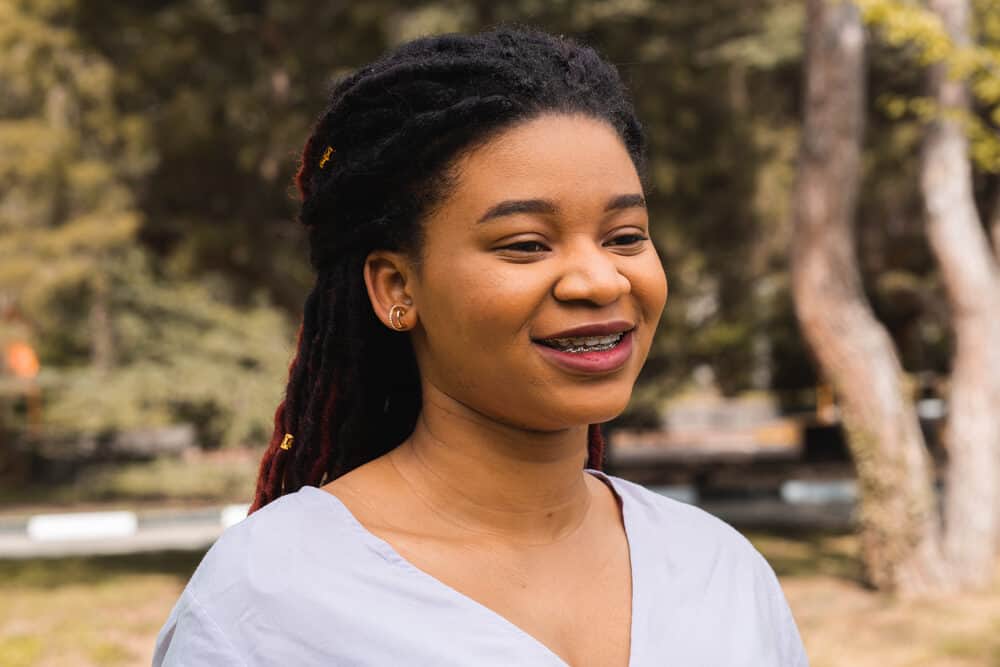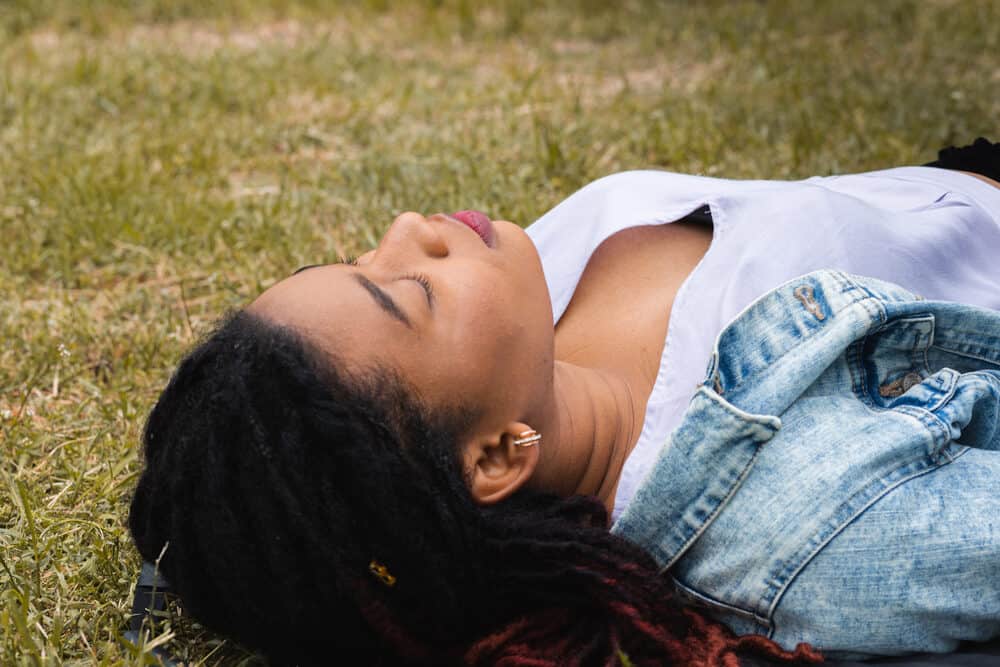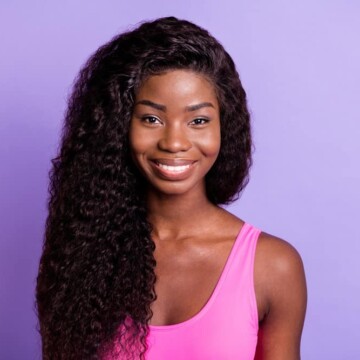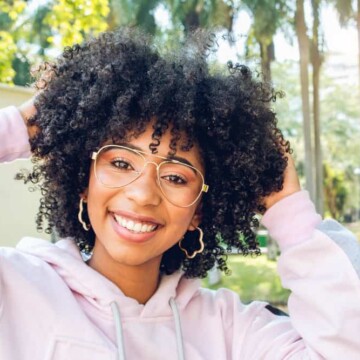
After deciding to start dreadlocks, you'll need to determine the size of your locs. Since there are many dreadlock size options, from thick traditional locs to the tiniest of all - Sisterlocks - many people are confused about which size to get.
If that sounds like your problem, you’re in the right place. In this article, we’ll cover everything you need to know about loc sizes and how to choose the right one for you. Let’s get right into it!
Table of Contents
Dreadlock Size Chart: Loc Sizes Available
Before you choose a loc size, you must be aware of all your choices. In this section, we’ll share the three main size categories with you:
- Sisterlocks - Sisterlocks are the smallest locs (i.e., thin dreads) of them all. The parts for sisterlocks range from ⅛ of an inch to ⅜ of an inch. You can get small, medium, or large sisterlocks, but the largest sisterlocks are still extremely thin locs. The smallest sisterlocks are about the size of fine yarn in terms of thickness.
- Microlocks - Microlocks are larger than sisterlocks but smaller than traditional locs. Some microlocks are as thin as a shoelace, while others are as thick as a drinking straw. If you do some internet research, you’ll probably see microlocks as small as sisterlocks.
- Traditional locs - Small locs will be about the size of a chopstick, medium ones will be the size of a pencil, and thick ones will be the size of a Sharpie marker.
Key Takeaways
- Locs Type and Size: There are three primary locs types. Sisterlocks are the thinnest. Microlocks are medium, and traditional locs vary from small to thick. The right loc size depends on your styling preferences, hair volume, and thickness.
- Dreadlock Measurements: The size and number of locs depend on your hair texture, length, and desired fullness.
- Maintenance and Loc Journey: The loc journey requires time and dedication. For instance, retwisting medium locs is faster than retightening smaller locs. It's essential to consider your hair texture and the loc style you want. This will make your journey easier.
- Hair Coverage: People with thin natural hair should opt for thinner locs for a fuller look. If you have thick hair, be careful not to have too many locs. This can make your hair look bulky.
- Loc Accessories: Loc jewelry, including dread beads, can be used for personalization.
- Consult Professionals: For advice, find an experienced loctician, especially for specialized styles like Sisterlocks.

How to Determine Your Dreadlock Size
Now that you know your dreadlock size choices, let’s get into how to achieve each of the loc sizes. For many, achieving a specific loc size is as simple as knowing how many locs you need and creating that amount of locs.
Disclaimer: Variations in hair density and thickness can affect the final size of your locs. For instance, two people can have the same number of locs and end up with different loc sizes. So, while knowing information about loc counts can be helpful, it’s not an exact science.
Microlocks (150+ dreadlocks)

Microlocks are a favorite among DIYers, as they look similar to Sisterlocks and can be done by almost anyone. On average, people who are going for microlock-sized dreadlocks should shoot for a minimum of 150 locs.
If you want your microlocks to be really small, go for 400 locs or more. Keep in mind that it will take quite a bit of time to start with such a high number of locs.
Traditional Locs (20 to 150 dreadlocks)

Traditional locs vary in size from small to thick, so we’ll tell you how many locs you need for each size category.
For thick traditional locs, you should aim to create 20 to 50 total locs. The fewer locs you have, the thicker your locs will be. If you want your locs to be extremely thick, closer to 20 locs will be your best bet.
It’s important not to go for less than 20 dreadlocks because that would result in extremely thick locs that don’t get fully dry. This can lead to mold and mildew growth which can be difficult to get rid of.
For medium-sized traditional locs, you’ll need to create anywhere from 51 to 100 locs. If you have thin hair and you want pencil-sized locs, you should lean more towards 51 locs. And if your hair is on the thicker side, go for closer to 100 locs.
For small traditional locs, you’ll need around 101 to 150 locs. The same principle applies to this loc size category as well. Those with thick hair should create closer to 150 locs, while those with thin hair should go for about 100 locs.
Sisterlocks (More than 400 dreadlocks)

Sisterlocking is a proprietary locking technique that uses a specific grid and the expertise of a Sisterlock certified professional.
So, if you’re interested in Sisterlocks, we recommend checking out the Sisterlocks Certified Consultant Registry, where you can find a professional in your area to start your Sisterlocks the right way.
Depending on the density of your hair, you could end up with more than 400 locs, and creating the perfect parts to achieve that number of locs may be challenging.
How To Choose Dreadlock Size for Newbies
When choosing your dreadlock size, you should consider your personal preference, how much time you want to dedicate to maintenance, your hair budget, and more. We will go into each of these considerations in detail.
- Time - Though locs are low-maintenance compared to many other hairstyles, they still require a time commitment. Locs should be maintained via interlocking (retightening), retwisting (e.g., two-strand twists), palm rolling, or crocheting. If you’ll be doing your own dreadlock maintenance, then you’ll have to determine how many locs you’re up for maintaining. Retwisting 20 locs takes much less time than retightening 400+ locs, which can take days. If you’re not up for long dreadlock maintenance sessions, choose a lower number of locs.
- Money - Even if you’re not going to be maintaining your own locs, you still have to make sure that you can afford the costs associated with professional dreadlock maintenance. Professional retightening for Sisterlocks and microlocks could cost around $200 every 8 weeks. For traditional locs (e.g., free-form locs on natural hair), you can expect to pay anywhere from $50 to $100 every 4 to 6 weeks. The larger your locs are, the more you could save in loc maintenance costs.
- Personal preference - Your personal taste should also be considered when choosing your loc size. To find out what size you like, type “dreadlocks” into Google Images, explore Instagram loc posts and watch YouTube videos. You’ll eventually gravitate toward a specific loc size.
- Loc fullness - If you have low-density hair, you should opt for a smaller loc size, which will give you more locs. If you choose large locs, you could end up with scalpiness (where a lot of your scalp is showing due to inadequate loc coverage). If you don’t care about your scalp showing, this is a non-issue. Conversely, if you have high-density hair, you should be careful not to create too many locs. As your dreads mature, your locs could take on the bulkiness of a mop.
- Test out some loc styles - If you’re having trouble deciding what size locs will best fit your face shape, try faux locs (you can use human or synthetic hair) to get a sneak peek. Though your natural locs may turn out to be more weightless and flexible, being able to see how small, medium, or thick locs look on you may be all the confirmation you need to make a choice.
With the above tips and considerations, you’ve got all you need to choose the right dreadlock size for you.
Your loc size is extremely important, so we advise you not to start your locs until you’re sure what size you want. You don't want to waste your time cultivating the wrong-sized locs and then have to start all over again.

Combining Locs
One thing to be aware of is that you can combine certain locs down the line if you find that they’re too small for your liking, but you can’t separate locs that are too thick. So, if you’re on the fence between two similar loc sizes, it’s best to go for the smaller size.
What Size Dreadlocks Should I Get?
The size of your dreadlocks should be based on your personal preference. However, you might also consider maintenance needs and your hair density.
There are three sizes of dreadlocks: Sisterlocks (thin), Microlocks (medium), and Traditional locs (small to thick). When choosing a loc style, consider how much time and money you can spend on maintenance. Also, consider how full you want your locs to look and the appearance you like.
How Do You Find the Perfect LOC Size?
Consider your styling preferences when choosing the right LOC size since the sizes look different. Also, consider your time for upkeep, your budget, and your hair's thickness. You can also look at dreadlock images online, and test styles with faux locs. Remember, choosing a size you'll be content with is essential to avoid having to start over.
How Do You Measure for Dreads?
To measure for dreads, you primarily focus on the width of the base. For instance, Sisterlocks range from ⅛ an inch to ⅜ an inch. Traditional loc sizes vary, with small locs being about the size of a chopstick. Medium locs resemble a pencil's size, and thick ones are the size of a Sharpie marker. However, hair density and thickness can affect the final size. So, measurements aren't always exact.
How Many Dreads Do You Need for a Full Head?
The number of dreads needed for a full head depends on the desired size. For microlocks, you should aim for at least 150 locs, with smaller ones requiring upwards of 400 locs. Traditional locs range from 20 locs (very thick) to 150 locs (smaller). Sisterlocks, being the thinnest, require more than 400 locs for a full head. Remember, the number can vary based on hair density and desired fullness.
- How To Start Dreadlocks Naturally
- Starting Locs With Double Strand Twist
- Is Interlocking Better Than Palm Rolling?
- How To Attach Loc Extensions
It’s easy to get confused by the sheer number of possibilities you have when it comes to loc sizes. But with the right tips, you can come to the best decision for you before long.
For more tips, read this article about the origin and history of dreadlocks, styles, repairing thinning locs, and much more.
We hope that this article allows you to make a more informed decision regarding your loc size, and we wish you the best of luck as you explore your dreadlock possibilities.




